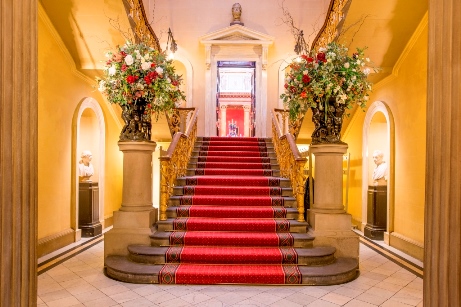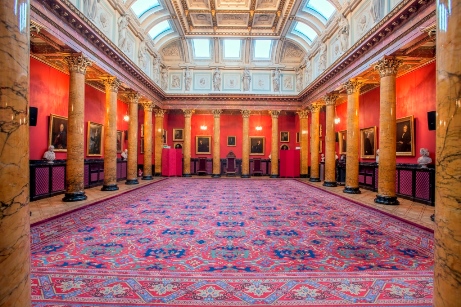
The present home of the College was built at No. 9 Queen Street to a design by Thomas Hamilton and completed in 1846. Carefully restored, the temple-like grandeur of the entrance hall and staircase is much as Hamilton, also the architect of the Burns Monument on Calton Hill, saw it. The stair balustrade is gilded with two coats of the finest gold leaf. The hanging lamps are one of the remaining original features of the design. Initially oil burning, the lamps were first changed to gas and then converted for electricity.
A bust of Hippocrates stands above the central door at the top of the stairs and Aesculapius, the Greek god of medicine, is above the entrance to the hall.
There are two large portraits on the staircase, of Sir James Young Simpson and Alexander Wood, both Presidents of the College and both medical innovators – Simpson discovered the anaesthetic use of chloroform, while Wood invented the modern hypodermic syringe.
The Great Hall
Part of Hamilton’s original design and later expanded by architect David Bryce, the Great Hall has been the scene of exhibitions, lectures and examinations throughout its history. Distinguished figures from medicine’s illustrious past line the space. Figures such as Galen, Hippocrates and Avicenna, from the golden ages of Greek and Arabic medical thinking, can be seen on the Hall’s south frieze.
Scottish practitioners share space on opposing friezes. On the west is Alexander Munro primus, who is credited with legitimising medical education in Edinburgh by incorporating it into university teaching. On the east can be found James Gregory, former President, physician to the King of Scotland and one of the founders of the Royal Society of Edinburgh. Alongside Gregory are William Smellie and John Hunter, both Scottish practitioners who made their names in London, working at the forefront of surgical and obstetric advances in England’s capital during the eighteenth century.
The lower level busts and portraits are mainly of distinguished Fellows and past Presidents.
Local tradesmen did the plaster work, although some of the busts and reliefs were purchased in London from Brucciani, the modeller to the British Museum.
The central chandelier includes parts of the old gasolier from Hamilton’s original hall.






